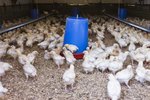Things You'll Need
Dust mask
Empty coffee can or gallon milk jug with the bottom cut off
One of the never-ending chores in caring for livestock is battling barn flies. Flies look for manure piles and wet barn floors to lay their eggs, so that when the maggots hatch they have plenty of food. Fly maggots can hatch as quickly as 24 hours after the female fly lays her eggs. Sprinkling barn lime on damp floors helps keep the fly population down; flies won’t lay eggs in a dry environment. Barn lime, also known as ag or garden lime, is not actually “lime” at all. It’s made from a crushed stone called dolomite, which is why it’s safe for you to handle and safe for your animals. It’s also used by farmers to control crop soil acidity. Barn lime is a useful tool in controlling your barn fly population.
Put on a dust mask if your barn does not have good ventilation.
Scoop out a can-full of barn lime from the bag.
Find a damp spot on your barn floor. Liberally sprinkle the barn lime over the spot, completely covering it.
Sweep up the barn lime when it becomes damp or soiled and replace it if the spot is still damp. Dispose of the old barn lime in the compost heap.
Tips
You can use barn lime on dry barn floors to help keep the barn clean. It’s an odor absorber, antibacterial and makes the floors easier to sweep.
Warnings
It is extremely important to use the correct kind of lime in your barn. Hydrated “burn lime” is caustic to people and animals if handled or inhaled. This should never be used in your barn or around animals. Barn lime is gray; hydrated lime is white and will carry a warning on the bag.
References
Photo Credits
-
Thomas Northcut/Lifesize/Getty Images
Writer Bio
Rachel Spradling is a writer and editor with over 14 years of experience writing everything from political commentary to training manuals. She graduated from California State University, Chico with a Bachelor of Arts in English. Spradling's work has appeared in "CitiZen" magazine, "Watershed" and "News and Review."




